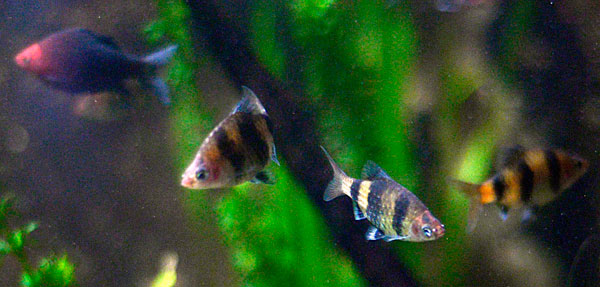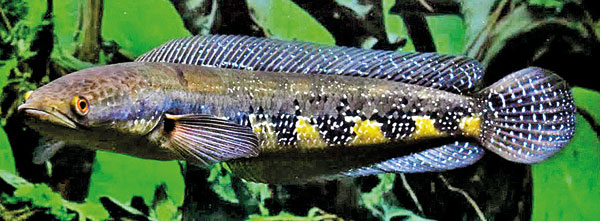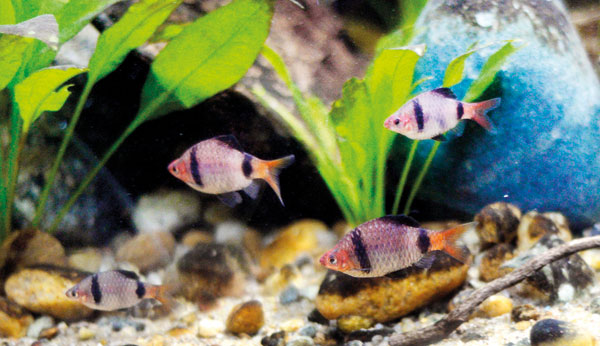News
Aquariums doing underground trade in native freshwater species
View(s):By Kasun Warakapitiya
With the Department of Wildlife Conservation (DWC) undecided about approving the rearing and captive breeding of several endemic species of fish, the illegal business of selling protected species of fish at aquariums and via social media is thriving.
Most monster fish (large fish) keepers as well as hobbyists who are interested in collecting endemic and rare species of fish continue to snatch fish from rivers, ponds and pools.

Black Ruby Barbs
Social media has become the hub of advertisements for the sale of wild-caught fish. Among the fish sold are the endangered Sri Lanka Giant snakehead (Channa ara) locally known as ‘Gan ara’ and the vulnerable Ceylon snakehead (Channa Orientalis), called ‘Kola Kanaya’.
Several social media groups promoting monster fish rearing are also secretly advertising the sale of local endemic fish protected under the Fauna and Flora Ordinance. The Sri Lankan Giant snakehead is the largest freshwater fish in Sri Lanka.
One such person from Kalutara was advertising the sale of a one foot Sri Lanka giant snakehead fish for Rs 5,500. Another person said he had 25 pairs of giant snakeheads and was selling a pair for Rs 1,500. The person who claimed anonymity said that he uses chicken as feed.
An aquarium operator at Godagama area said that he, too, was selling a pair of eight-inch giant snakeheads for Rs 3,500. He added that he feeds them chopped fish and that he receives fish from people. But he failed to explain from where he received the fish.
Environmentalists pointed out that fish which are endemic and endangered cannot be allowed to be collected from the environment as that would be detrimental to populations which are already in the decline.

Sri Lanka Giant Snakehead
Environmental lawyer Jagath Gunawardena explained that according to the Fauna and Flora Protection Ordinance, the endemic fish species scheduled under it cannot be collected from the wild, held in captivity, or be exported.
There are some species of fishes such as black ruby barb (Pethia nigrofasciata) also known locally as Bulath hapaya, which can be captive-bred and exported under a permit obtained from the Department of Fisheries and Aquatic Resources.
However, fish such as Ceylon snakehead and Sri Lanka Giant Snakehead which are classified as vulnerable and endangered, are protected under the Fauna and Flora Protection Ordinance.
“If we are exporting wild forms of endemic fish, we are supplying raw material for foreign aquarium fish breeders to obtain our fish’s genetic material and create new varieties, we should expand our technical capacity and create new varieties and deliver a final product that has a local identity.’’
Environmentalist and founder of the Customs’ Biodiversity Protection Unit Samantha Gunasekara explained that over 20 years ago he came up with a concept of breeding local fish species and using them to re-populate in the wild as well as introducing the species to the aquarium industry for exporting.
He said when the proposal was made, conservationists, environmentalists as well as the DWC were against it. “The persons in the aquarium business, too, were to blame as they caught and sold fish from the wild instead of breeding them.’’
Strict laws, monitoring and a national action plan is required if the people in the aquarium fish trade are allowed to carry out breeding of endangered species of fish and exporting them, added Devaka Weerakoon, professor in zoology at the department of zoology and environment sciences of University of Colombo.
He elaborated that collecting fish from the wild needs to be strictly regulated as removing fish from local populations which have less than 1,000 individuals could negatively impact the population.
He explained that most fish species have become endemic as they have adapted to specific environmental conditions. Most of the endemics are rare and to breed them, these conditions need to be mirrored.
“There are point endemic species such as Bandula Barb (Pethia bandula) which is found in a small stream in Galapitamada area,” he said adding that many endemic species such as Asoka Barb (Systomus asoka) are classified as restricted range species as they are restricted to a small part of a river basin.
Prof Weerakoon added that as there are no regulations on fishing and live collection the absence of a formal monitoring system can decimate wild populations.
Meanwhile, DWC’s Director General Chandana Sooriyabandara told the Sunday Times that their priority is the protection of biodiversity of Sri Lanka. Therefore they are not interested in the raw genetic material of endemic species being shared internationally.
“There have not been any laws created for the sale or breeding of endemic fish which are hybridised or bred as new species created out of endemic species and until that is done via a policy decision of the Government, we would implement the prevailing laws,’’ he said.
“If the Government takes policy decisions on allowing the breeding and export of endemic species we would follow it while ensuring safety of the endemic fish gene pool.’’
He explained that legal action would be taken against persons who remove endemic and endangered fish from their natural habitats as well as those illegally rearing and selling.
| Law amended to scuttle bio pirates Biodiversity scientist, Dr Rohan Pethiyagoda explained that Sri Lanka used to be famous as a source for ornamental fish. Species such as the Black Ruby Barb (Pethia nigrofasciata), Cuming’s Barb (Pethia cumingii), the Giant Danio (Devario malabaricus), and Cherry Barb (Rohanella titteya) were widely exported until the early 1990s. These were among the best-known aquarium fishes in the world. He believes that his book “Freshwater fishes of Sri Lanka” published 1990 drew attention to the fact that many of Sri Lankan freshwater fish were threatened. In addition, the Convention on Biological Diversity in 1992 produced a great deal of hype about bio piracy. As a result, Sri Lanka amended the Fauna and Flora Protection Ordinance in 1993 to severely restrict, in effect to prohibit, the commercial export of indigenous species, especially endemic species, including freshwater fishes, he said. The law was tightened once more in 2009. Biodiversity scientist, Dr Rohan Pethiyagoda further elaborated the reasons for a total ban of wild caught and captive bred fishes. He explained that if allowance was made for captive-bred fishes, it would enable unscrupulous businesses to use this as a loophole to export wild-caught fishes. Added that the other reason for a total ban was to prevent the genetic resources of Sri Lankan species being exploited for commercial gain overseas. Excerpts of the interview Q: Did the restrictions apply to wild-caught fish as well as captive-bred fishes? A: Yes. The law did not distinguish between the two. I think the reason for this was that if allowance was made for captive-bred fishes, it would enable unscrupulous businesses to use this as a loophole to export wild-caught fishes. The other reason for a total ban was to prevent the genetic resources of Sri Lankan species being exploited for commercial gain overseas, for example in the development of new pharmaceuticals. The 1992 Biodiversity Convention greatly hyped the value of the so-called “green gold” of biodiversity rich countries such as Sri Lanka and promised that we could earn billions of dollars in royalties from “sustainable use” and “benefit sharing”. This proved to be a damp squib, and no country has earned significant income as a result of the Biodiversity Convention in the three decades since it came into being. Q: Given Sri Lanka’s desperate need for foreign exchange right now, would it make sense to change the law now to liberalize the export of ornamental freshwater fishes? A: First off, I am against the export, or even consumption, of any wild resource. Farming is the hallmark of a civilization, not “hunting and gathering”. Personally, I believe that all wildlife resources that are not critically endangered, whether plant or animal, should be permitted for export on condition that they have been farmed or cultured sustainably in Sri Lanka, and that ethical concerns regarding the welfare of animals have been addressed. After all, what is the use of having a “resource” if you don’t use it? However, we need to have at the same time an effective way to prevent creating a loophole by which unscrupulous businesses will export wild-caught plants and animals in the guise of farmed plants and animals. This means establishing a strict monitoring regime. There is no reason this cannot be done. After all, it is already done for the export of ornamental plants and horticulture products. Between the Department of Wildlife Conservation and the Agriculture Department, they do an excellent job regulating this industry proactively and keeping this valuable export market thriving. Q: So, do you recommend amending the law? A: Yes, it will need an amendment. I don’t advocate lifting all restrictions in one fell swoop. There must be safeguards and an effective regulatory framework. But there is a definite need for a change in public attitudes on this question. The present restrictions are so stringent that they impede even conservation actions. | |
|
Zoo breeding declining endemic species The curator of the Dehiwala zoo’s reptile and aquarium sections Sumedha Abeysinghe told the Sunday Times that the population density of the endemic fish species has reduced over the years. He added the Department of Wildlife is strict on capturing wild species of fish and only allows the National Zoological Gardens to obtain animals from the wild under a permit for conservation activities such as captive breeding and release programmes. “According to the Fauna and Flora Protection Ordinance it is illegal to raise, sell or remove animals from the wild,’’ he said. The zoo is carrying out captive breeding programmes for endemic species of fish which are in decline. “We have currently bred Bandula Barb (Pethiya bandula) locally known as Bandula Pethiya,” he said. He said that they are planning to introduce the fish to a suitable area after quarantining.  Bandula Barb Pix by Eshan Fernando |
The best way to say that you found the home of your dreams is by finding it on Hitad.lk. We have listings for apartments for sale or rent in Sri Lanka, no matter what locale you're looking for! Whether you live in Colombo, Galle, Kandy, Matara, Jaffna and more - we've got them all!

